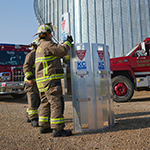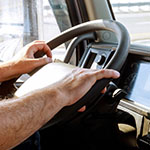Defense wins championships, defensive driving saves lives
Minimizing risk and avoiding traffic accidents keep commercial vehicles, farm equipment drivers, and others safe on the road. When drivers put the safety of other drivers alongside their own, they are practicing defensive driving.
Defensive driving means predicting hazards and minimizing risk as much as possible. While getting their load from point A to B, drivers must drive with caution, paying attention to their surroundings and the rules of the road.
Encourage your drivers to adopt the following defensive driving safety tips:
- Buckle up and make it click: Wearing your seatbelt is required by law in most states and prevents death and reduces injuries.
- Look far enough ahead: While focusing on the traffic around the vehicle, look ahead a few seconds. This approach provides a driver with a view of the following:
- Oncoming traffic
- Vehicles and objects entering the road
- Warning signs
- Slow moving vehicles construction
- Pedestrians and animals
- Stopped vehicles
- Expect other drivers to make mistakes: Be aware of surrounding and oncoming traffic and expect them to make errors.
- Be healthy and rested: Take well-timed breaks throughout the day. Driver safety often hinges on getting enough sleep and rest. Fleet and farm drivers should eat healthy, exercise, and evaluate their mental health to stay in top form.
- Avoid distractions: Cell phones and even radio communications create distractions that take a driver’s focus off the road. Distracted driving can lead to loss of life. Other common distractions for commercial vehicle drivers include:
- Taking calls
- Texting
- Eating and drinking
- Listening to loud music
- Adjusting radio and navigation system
- Multitasking
- Life and job stress
- Be weather aware: Truck drivers should stay alert to weather, road conditions, and potential changes during their journeys. Dispatchers can help provide updates along the way.
- Know your speed: Drivers should adapt their speed to the road conditions, prioritize safety over adhering to strict speed limits. When navigating turns and curves, reduce speed and remain vigilant, especially in areas with low visibility.
- Maintain safe driving distance: Distance with change with speed and other factors. Maintain a following distances of one second per every 10 feet of vehicle length. Add a second for every adverse condition, such as driving at night, rain, increased speeds, slick roads, and heavier-than-normal loads.
- Check your mirrors and blind spots: Commercial drivers must check their mirrors and blind spots frequently to avoid accidents. Scan surroundings as best as possible and use signals before crossing landers or turning.
- Avoid backing up your truck: Backing up a truck increases the chance of hitting other drivers and pedestrians. Always try to park to drive forward and avoid potential collisions. If backing out is necessary, drivers should use a spotter to direct them and avoid traffic/pedestrians.
References
Virginia Department of Motor Vehicles. Safe Driving. https://www.dmv.virginia.gov/sites/default/files/forms/dmv39d.pdf
California Department of Motor Vehicles. Truck Drivers. https://www.dmv.ca.gov/portal/driver-education-and-safety/special-interest-driver-guides/truck-drivers/

 >
>

 >
>
 >
>